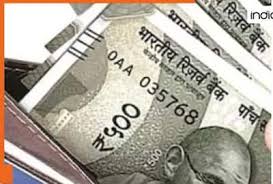Digital News Guru National Desk:
8th Pay Commission
India’s pay commissions, convened roughly every 10 years, reassess salaries, pensions, and allowances for federal government staff — including civilian officials, defence personnel, and pensioners. The current 7th Pay Commission was implemented in January 2016 and ends in December 2025. The 8th Commission, constituted earlier in 2025, is now finalizing its recommendations.
The Big Number: 30–34% Hike?
- A report by Ambit Capital, featured in several financial outlets, projects a 30–34% increase in basic pay and pensions, directly impacting about 11 million recipients — roughly 4.4 million employees and 6.8 million pensioners

- Financial estimates indicate this could cost an additional 1.8 lakh crore from the exchequer.
- The underlying driver is a proposed fitment factor—a multiplier applied to current basic pay—ranging between 1.83 and 2.46.
Example:
-
- If the minimum basic pay is 18,000, applying a lower-end fitment factor (1.83) yields 32,940. At the high end (2.46), it reaches 44,280.
- Similarly, a 50,000 base could rise to between 91,500 and 1.23 lakh.
What’s Changing in the Pay Structure
- Basic Pay gets multiplied by the fitment factor.
- Dearness Allowance (DA)—about 30% of total pay—typically resets to zero when a new commission starts and is rebuilt over time.
- Other components like House Rent Allowance (HRA) and Transport Allowance (TA) adjust accordingly, and a rationalization of allowances is anticipated.
With an overall compensation boost, employees may experience a direct uptick in take-home pay, though actual impact depends on how DA and allowances are rolled out.
Timeline: When Will This Come Into Effect?
- Recommendations expected by December 2025.
- Official rollout is projected for January 2026, though some analyses argue FY 2027 (April 2026—March 2027) is more realistic.
- Historical precedent underscores caution: the 7th Commission took nearly two years to fully implement.
Delays in implementation could mean:
- Mounting arrears — employees may receive lump-sum retroactive payments.
- Frustration from persistent inflation, as DA remains low until adjustments are made.
- Broader fiscal budget implications — large one-time payouts would significantly impact the government’s finances.

Who Gains & How Much
- Beneficiaries include circa 4.4 million serving and 6.8 million retired central government staff — totals exceed 11 million.
- This group constitutes about 0.7% of India’s labour force yet is a significant 9% of the organised sector.
- Lower-paid employees stand to benefit most percentage-wise, with compensation gaps likely to narrow. Pensions too will increase via the same fitment logic.
Economic & Societal Ripples
- Consumer spending boost: A 1.8 lakh crore pay rise could translate into higher consumption—on housing, healthcare, and discretionary items.
- Inflation implications: The hike may nudge the DA index upward, potentially adding to inflationary pressures. Care will be needed to ensure real wages maintain purchasing power.
- Public sector morale: A progressive compensation structure can enhance employee morale and retention—while delays may erode trust .
Potential Headwinds & Risks
- Fiscal Strain — The substantial cost could pressurize the fiscal deficit, especially if delays push payouts further.
- Implementation delays — These could amplify arrears and create administrative bottlenecks.
- Disparities across sectors — Synchronizing private and public compensation might raise competitiveness issues.
- Political timing — Precision in rollout is crucial amidst election cycles and policy narratives.
What’s Ahead: A Snapshot
| Stage | Expected Timelines | Key Actions |
| Commission Setup | Jan 2025 | Cabinet approves formation |
| Report Submission | By Dec 2025 | Ambit Capital forecasts |
| Rollout Begins | Jan 2026 (target) | Likely to slip into FY 2027 |
| Hike Takes Effect | FY 2027 | Retroactive arrears probable |
| Fiscal Outlay | FY 2026‑27 | 1.8 lakh crore burden |
Conclusion
The impending 30–34% basic pay and pension increase under the 8th Pay Commission could prove transformative for over 11 million central government beneficiaries. While the expanded pay structure promises financial uplift and economic stimulation, its success hinges on timely implementation and manageable fiscal absorption. A slip into FY 2027 remains a real risk, which could delay benefits and inflate arrears.
What to watch in the coming months:
- Official notification of the final fitment factor
- Release of the Terms of Reference and Commission members
- Budgetary allocation in Budget 2026
- Clear government communication on rollout timings and DA adjustments
When the final report lands—and especially after the board meeting around July 19—I’ll keep you updated on exact figures, implementation dates, and the full impact breakdown.
You May Also Read: Kiara Advani & Sidharth Malhotra Welcome Their Baby Girl, “Our Hearts Are Full”









